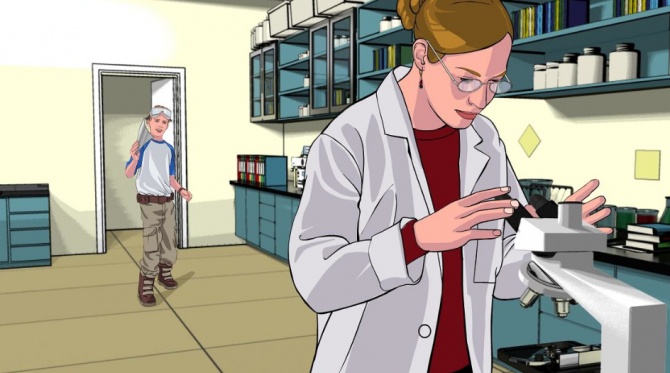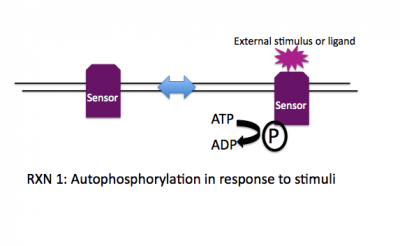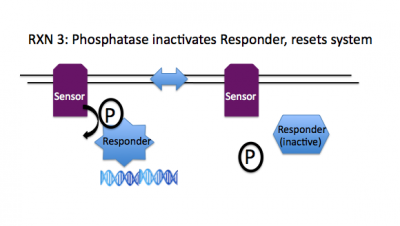20.109(F09): Mod 2 Day 2 Measuring system performance
Contents
Measuring System Performance
Introduction
Operation of System's Devices
Two Component Signaling
As was mentioned last time, the bacterial photography system exploits a common signaling pathway in prokaryotic organisms, namely the "two component signaling" (2CS) pathway. As you learned, the two components are the sensor and the responder molecules and they are sensitive to changing environmental conditions. Hundreds of signaling pairs have been identified, and though variations are plenty, there is a common theme to the signaling mechanism the two components use. In general the communication of the 2CS pair is via a three reaction "phosphorelay."
Rxn 1: ATP + SensorHis --> ADP + SensorHis~P
Stimulation of the sensor by a ligand (or a change in the environment or a detectable cellular input) leads to a change of state for the sensor, e.g. it may dimerize, change conformation, etc. This altered state stimulates the autophosphorylation activity of the sensor and the gamma-phosphate from ATP is transferred to a histidine on the cytoplasmic face of the sensor. Thus another name for the sensor molecule is "histidine protein kinase" and when a number of sensor molecules are compared, the histidine that is phosphorylated can be identified based on conserved sequence motifs that surround it.
Rxn 2: SensorHis~P + ResponderAsp --> SensorHis + ResponderAsp~P
To transduce the signal from sensor at the membrane to an effector molecule within the cell, the phosphate on the conserved histidine of the sensor is transferred to an aspartate molecule on the responder. The phosphorylation state of the responder regulates its activity. In many cases, the phosphorylated aspartate enables the responder to bind the DNA and regulate genes that provoke a sensible cellular response to the initial stimulus...swimming to the good food, transcribing pores to let in ions, etc.
Rxn 3: ResponderAsp~P + Sensor + H2O --> ResponderAsp + Sensor + Pi
To reset the signaling system, the phosphorylation state of the regulator must be returned to its original set point. A phosphatase activity is associated with many of the sensor molecules in 2CS paths, enabling a single molecule to both enhance and diminish the signaling of a condition and provoking the necessary response.
Black box abstraction
The bacterial photography system we are studying modifies a natural osmolarity signaling pathway in E. coli so that light striking the cell can be converted to a detectable output (β-galactosidase enzyme that works on a chromogenic substance).
A “black box” depiction of the system looks like:
Some of the details within each box are:
This figure is more detailed but harder to decipher without prior understanding of several aspects of the system. For example, light at 660nm is detected by the input-sensing device, turning it off. Light-sensing requires the combined action of two sets of proteins: Cph8, itself a fusion of a light-sensing protein called Cph1 that comes from an algae attached to a transmembrane signaling protein called EnvZ, and phycobilin producing proteins that generate accessory pigments needed for the light-sensing protein to work. The input sensing device generates a signal within the cell’s osmoregulation pathway (OmpR is the signal carrier), changing the activity of an OmpR regulated promoter that is directing transcription of the output: lacZ….whew! The black boxes were a whole lot easier.
Today you will assess the system, both in terms of enzymatic activity measurements as well as a resulting bacterial photograph. Next time we'll start to "tune" the system in order to expand the dynamic range of the system.
Protocols
Part 1: β-galactosidase assay
You should perform assays on your overnight liquid cultures that were grown in the dark and the light. Refer back to the protocol from day 1. Activity calculations for today's samples will be part of your assignment for next time.
Part 2: Black and white photography
Retrieve the Petri dishes you set up last time and compare the appearance of the light and dark grown samples. Because the dark grown cells were in a completely dark box, the difference between the two plates reveals the greatest contrast you can expect in your bacterial photographs. You should take a photograph (digital!) of these petri dishes since the result will be included in the final research article you write for this module.
Next decide what image you would like to develop as a bacterial photograph. Generate a computer file with this image and print it to a transparency. Transparencies will be available in the lab for you to use as masks. As you choose an image, remember that the goal is to have each cell growing distinctly in the light or dark. Remember that light can bounce around edges and may blur the resulting image if the black and white are highly intermingled. In general, it’s better to have a dark background and a light image rather than the other way around. To darken the dark parts of your photo, you might want to print it on two transparencies and use them both to mask your Petri dish.
Media containing S-gal is available for you to supplement with antibiotics and cells as you did last time. Once you've supplemented and poured a plate, cover the dish with Saran (tape to keep in place) and use the point of some scissors to cut several slits in the saran. Next you can tape the transparency to the saran covering the Petri dish. Place your bacterial photograph in the 37° incubator (no lid) and when the class is ready, we'll turn on the red-lamp to expose the "coliroids" until next time. You will want to adjust the placement of the dish in the incubator once the light is on. The rule of thumb is the light image on the plate should be clearly visible but not super bright. If you can see the image clearly, and it doesn't look dim, you're probably in the right range.
Part 3: Instruction on Oral Presentations
Over the course of the term, everyone taking 20.109 will be making two presentations to the class. One will be a presentation of a primary journal article related to either 2 component signaling systems or synthetic biology. The other presentation will be of a research idea. Today our wonderful coaches from the Writing program will come to lab to give a talk about giving talks. This presentation should be a welcomed chance to learn what's expected when you speak (in 20.109 and elsewhere) and to gather some great tips for giving polished and interesting seminars. You can follow up this instruction by re-reading the oral presentation guidelines we've assembled for this subject.
DONE!
For Next Time
Calculate the units associated with the bacterial photography system grown in the light and the dark. Use this data and the photographs of your petri dishes grown in the light and the dark to draft Figure 1 of the research article you'll write for this module. Be sure this figure has all the traditional elements for figures (title, legend, labels etc).






